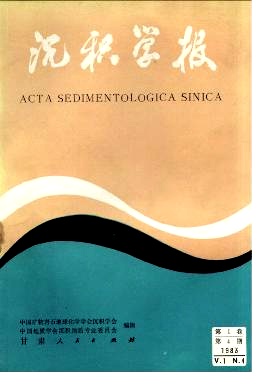SILICIFICATION OF SPONGE REEF OF UPPER PERMI JIANTIANBA,LICHUAN COUNTY,HUBEI PROVINCE
- Received Date: 1982-07-28
- Publish Date: 1983-12-10
Abstract: The sponge reef exists in the second member of the Changxing formation,Upper Permian.M ost reef-building organisms consist of porataoidea and aporata-oidea of sphinctozoa and so me species of fibrous spongia,while stromatoporoids,bryozoa,coral colonies,hydrozoa and tubiphytes come second. Non-skeletal blue-algae have formed binding-coat or coat. Their abundance influences the reef-building mode.Reef-liked organisms are mostly composed of brachiopoda,gastropod,crinoidea,bryozoa of cryptomata and foraminiferas The reef develop went process can be divided into three stages: (1)Initial stage:Bafflestone is formed but algal-binding process is very weak。(2)Vigorous stage:Reef-building organisms are so abundant and vigorous that frameworkstone is constructed。Algal-bindsting process gradually becomes strong,and bindstone is formed at the late stage.(3)Decay stage:Algal-bindstone develops.The formation of the dolomite cap of 15 meterthick and the porphyritic dolomite of different sizes of the rest of the reef indicate that later on the top of the reefis exposed to the sea surface and dorag dolomitization takes place.Fram eworkporositp is successively filled by fibrous and bladed spar calcites.Silicifi cationdevelop later because silica is found to replace coarse spar calcite.It is very common in China that there are siliceous belts and large nodules in the carbonate rock of the Upper Permian. But such a silicified phenomenon has not been found in the Lichuan sponge reef. Silicification is so weak that there are only siliceous micro-nodules in the reef, ranging from 0.1 mm to 1 mm in size,the largest being 5mm and the smallest 0.01mm. Their section is nearly round or irregular. Silica mainly replaces carbonate organisms and minerals,silicification can not be found near and at the reef top of dolomite cap. Silica mostly replaces fibrous and bladed calcite cements,then grained spar calcite cements and partly the skeleton of bryozoa and sponge.The dimension and shape of nodules are often controlled by mineral fabric andthe growth of the nodules is usually restricted by the width of fibrous and bladed calcite cement belts. The crystal habit of nodules makes the section oblate-long or elongate. The nodules at the bend in a cement belt take flexural shape.The nodules are mainly composed of elongate quartz and a bit of lutecite and microlitic quartz,and they are arranged in a radiating or semi-radiating way except microlitic quartz. As there are residual crystal and insoluble impurites of calcite, the nodules are characterized by the incomplete replacement. When observed under a simple nicol,the remains of fibrous and bladed calcites in quartz-ferous nodule are dirty brown-grey in color and keep the optic character of calcite fib under crossed nicols. The nodule outer margin in a thin section takes clean and transparent hackle shape.In addition,a few nodules arc composed of microlitic quartz,too. The skeletal crusts of brachiopods,foraminiferas and ostracods are replaced by euhedral grained and microlitic quartz under silicfication but the replacements are eetremely incomplete.The spectral aaalysis shows that the silica content in the sponge reef is much lower (only 0.06-1%)than that in the carbonatite of the contemporaneous basin facies (6 %)and that in its underlying layey (10%).This results from abundant calcareous but few of siliceous organisms.The replacement relationship indicates that all siliceous nodules and authigenic quartz are formed by replacement and their formation is later than that of siliceous belt and large nodules of the carbonatite of non-reef facies. Perhaps the silica still results from the continuous dissolution of radiolarla and siliceous sponge spicules in the sediments of the contemporaneous basin and its underlying layer.As a result of the differential compaction,the silicic water flow into pore space of the reef. Later on,when the top of the reef is erposed to the sea surface,a gteat amount of fresh water begin to infiltrate and mix with silicic pore water.so the pH value becomes low.At the moment,the replacement of Si02 occur and mixed water gives rise to dolomitization.Because mixed water is unsaturated to calcite but is supersnturated to dolomite replacement does not take place in dolomite.It is obvious that the effect of silicification on the reservoir property of intercrystaline pore of dolomite is not important.
| Citation: | Fang Shaoxian. SILICIFICATION OF SPONGE REEF OF UPPER PERMI JIANTIANBA,LICHUAN COUNTY,HUBEI PROVINCE[J]. Acta Sedimentologica Sinica, 1983, 1(4): 30-38. |






 DownLoad:
DownLoad: